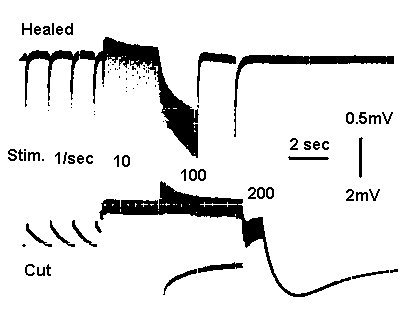The Nerve Impulse Seen from Outside
Dexter M. Easton July 2000 ©Next topic Previous topic Table of Contents
Topic 19: After-potentialsThe spike is really only the early part of a nerve impulse, which consists, in its entirety, of a succession of progressively diminishing waves traveling away from the point of origin. The spike of the action potential is the first, largest, most rapidly changing and briefest of these waves. More slowly changing, smaller waves that follow in succession are hyperpolarizing and depolarizing after-potentials, mentioned in Topic 11. After-potentials can last for tens of milliseconds to several seconds, even minutes.
An external after-potential is smaller and involves a gentler longitudinal gradient than the spike, but with high amplifier gain, and low sweep speed of the CRO trace, it can be revealed (Fig. 19). The external after-potential can be inferred from, but is not the same in time course as, the transmembrane after-potential (Fig. 11).
If, at high gain and slow sweep speed, the external record is sustained upward following the spike, it is called a "negative after-potential." It reflects a time of prolonged depolarization of the membrane. A sustained downward deflection seen under similar circumstances is a "positive after-potential." It is due to currents associated with hyperpolarization of the membrane. In Fig. 19, the vertical gain has been increased about 50-fold and the time scale slowed to 1/1000 of the normal to reveal these events.
Figure 19. After-potentials externally recorded.

Refer to Figs. 10, 11, and note that the early downward deflection of the external record reports the slope of the transmembrane potential. The downward phase of the diphasic external record of the action potential spike is not an after-potential and does not signal an after-hyperpolarization of the transmembrane potential.
Figure 19A. After-potentials before and after cut.

Recalling that downward deflection means current going toward the end, try to make sense of these records.
Next topic Previous topic Table of Contents

